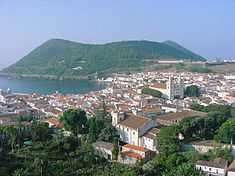Cais da Alfândega (Angra do Heroísmo)


The Wharf of the Customshouse (Portuguese: Cais da Alfândega) is located on the edge of the Bay of Angra, in the civil parish of Sé, municipality of Angra do Heroísmo, on the island of Terceira, Portuguese archipelago of the Azores.
The anchorage is the oldest wharf in Angra do Heroísmo, established after the first settlers began arriving between 1470 and 1500, at the time when Álvaro Martins Homem promoted its colonization.
This wharf connected directly through the city gates to the Pátio da Alfândega (Customhouse's Patio/Varanada), the hospital of the Misericórdia (along the Rua de Santo Espírito) and the building from which good were registered and warehoused for the town. Many of the boats that transited the waters of the North Atlantic passed through Angra on their way to and from the colonies of North and South America.
The oldest view of the old wharf was characterized in an engraving of the port around 1590, showing the anchorage alongside Monte Brasil. At that time, the ravine that flowed into the bay allowed naval repair, with its access along Rua de São João. Along Rua Direita a fortified passage existed that canalized the ravine's water to the port, where they supported naval ships.
For the following century little is known. It was a main hub for customs traffic, and the city gates acted as a symbol of the city's commercial authority. Repairs to the wharf were carried out in 1610, and the gates became a representation of the commercial power of the town, as it was an obligatory stop in trans-Atlantic traffic. The customhouse patio, which encircles the building in the east and south, helped businessmen, providing a line-of-sight to goods offloaded from shipping docked at the wharf.
The fortified gates also served as a protective structure since the middle of the 16th century, when it was integrated into the massive coastal defenses of Monte Brasil, along with the Fort of São Sebastião (to the east), the Fort of São Benedito and later the Fort of Santo António (to the west), which were ordered constructed by the Provisioner of Arms Pero Anes do Canto. The gate lasted 250 years, until an earthquake on 1 November 1755 (an aftershock of the 1755 Lisbon earthquake) caused an wave that inundated buildings until the old square (Portuguese: Praça Velha). The waters destroyed and dragged the structure.
